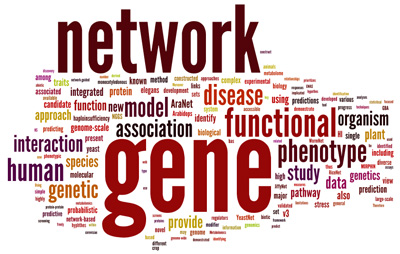Difference between revisions of "Research"
From Bioinformatics Lab
(→Collaborators) |
|||
| Line 15: | Line 15: | ||
*[http://www.marcottelab.org/index.php/Main_Page Edward Marcotte, University of Texas at Austin, USA] | *[http://www.marcottelab.org/index.php/Main_Page Edward Marcotte, University of Texas at Austin, USA] | ||
*[http://www.crg.es/ben_lehner Ben Lehner, Systems Biology Unit, EMBL-CRG, Spain] | *[http://www.crg.es/ben_lehner Ben Lehner, Systems Biology Unit, EMBL-CRG, Spain] | ||
| + | *Dongryul Lee, CHA Medical Center, Korea | ||
| + | *Dongwook Han Kunkook University, Korea | ||
*Jonghoon Kim, Korea University, Korea | *Jonghoon Kim, Korea University, Korea | ||
Revision as of 20:56, 27 October 2015
Research Summary

The ultimate goal of biological research is to manipulate traits that are important for medicine, agriculture, and bio-industry. This challenging task first requires good understanding of association between genotype and phenotype. Because of high complexity of genotype as well as phenotype, complexity of the genotype-phenotype association could be even untouchable by combinatorial explosion of the number of possible associations. Therefore, modern genetics needs to be more systematic and predictive. Recently we proposed network-guided approach for genetics of complex traits. First, we construct probabilistic functional gene networks for cells or organisms by benchmarking and integrating heterogeneous multi-omics data that are in general publicly available. Then, using guilt-by-association, and other algorithms of network propagation of known biological information, we predict gene functions, phenotypic effect of loss-of-function, and epistatic interaction. The information can contribute to reconstruction of map between genotype and phenotype. The network-guided genetics method has been effectively applied for various organisms; from simple microbe yeast, to multicellular animal C. elegans, to the reference plant Arabidopsis, to the reference crop rice, and to the human.
Research Highlight
- 2011 Nature Reviews Genetics, Research highlight (Predicting genetic interaction)
- 2008 Bioessay, What the papers say (WormNet)
- 2008 Genome Biology, Minireview (WormNet)
- 2008 Nature methods, Research highlight (WormNet)
- 2008 Nature Genetics coverstory (WormNet): Network perturbation predicts phenotype
Collaborators
Human/Animal Systems Biology
- Edward Marcotte, University of Texas at Austin, USA
- Ben Lehner, Systems Biology Unit, EMBL-CRG, Spain
- Dongryul Lee, CHA Medical Center, Korea
- Dongwook Han Kunkook University, Korea
- Jonghoon Kim, Korea University, Korea
Crop/Plant Systems Biology
- Sue Rhee, Carnegie Institution of Science, USA
- Pamela Ronald, University of California at Davis, USA
- Thomas Brutnell, Danforth Plant Science Center, USA
- Sangdong Yoo, Korea University, Korea
Microbial Systems Biology
- Yongsun Bahn, Yonsei University, Korea
- Sangsun Yoon, Yonsei Medical School, Korea